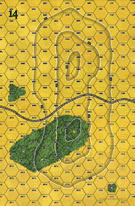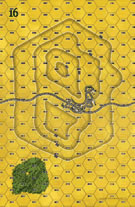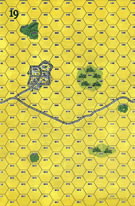|
Desert Blitzkrieg Power of the East #11 |
||
|---|---|---|
| (Defender) Japan | vs | Soviet Union (Attacker) |
| Formations Involved | ||
|---|---|---|
| Japan |  |
28th Infantry Regiment |
| Japan |  |
71st Infantry Regiment |
| Soviet Union |  |
11th Guards Rifle Regiment |
| Soviet Union |  |
11th Tank Brigade |
| Soviet Union |  |
293rd Rifle Regiment |
| Soviet Union |  |
602nd Rifle Regiment |

| Total | |
|---|---|
| Side 1 | 1 |
| Draw | 0 |
| Side 2 | 0 |
| Overall Rating, 2 votes |
|---|
|
2.5
|
| Scenario Rank: --- of 913 |
| Parent Game | Power of the East |
|---|---|
| Historicity | Historical |
| Date | 1939-08-20 |
| Start Time | 09:00 |
| Turn Count | 20 |
| Visibility | Day |
| Counters | 267 |
| Net Morale | 2 |
| Net Initiative | 3 |
| Maps | 8: 14, 16, 19, 3, 4, 5, 7, 8 |
| Layout Dimensions | 112 x 86 cm 44 x 34 in |
| Play Bounty | 253 |
| AAR Bounty | 171 |
| Total Plays | 1 |
| Total AARs | 1 |
| Battle Types |
|---|
| Delaying Action |
| Exit the Battle Area |
| Hill Control |
| Inflict Enemy Casualties |
| Conditions |
|---|
| Off-board Artillery |
| Randomly-drawn Aircraft |
| Terrain Mods |
| Scenario Requirements & Playability | |
|---|---|
| Eastern Front | Maps + Counters |
| Guadalcanal | Counters |
| Power of the East | Base Game |
| Road to Berlin | Counters |
| Introduction |
|---|
|
Twelve days before the German attack on Poland the world witnessed the first modern-style armored Blitzkrieg in history. Zhukov planned for frontal attacks to pin the enemy in the center, while armored columns broke through on both flanks and encircled the Japanese. Zhukov was not the military genius as described by Soviet history and propaganda, but an extremely rough and brutal man, even by Red Army standards, but one who understood the basics of infantry and mobile warfare. His hard-bitten approach and relentless zeal would later make him the highest ranking officer of the Red Army in the Great Patriotic War. |
| Conclusion |
|---|
|
Following their plan, the Soviets attacked along the whole front and their armored forces on the flanks immediately broke through the enemy lines. They caught the Japanese command completely off-guard who couldn't figure out the direction of the main strikes. As usual, the Japanese soldiers offered hard-bitten resistance, but again they were ground down by the overwhelming Soviet tank and artillery fire. On several occasions only their close combat skills could preserve the Japanese central position from a complete collapse where the Soviet advance was less successful than on the flanks. Several days into the offensive the Soviet armored pincers coming from north and south met around Nomonhan thus completing the encirclement of the whole Japanese formation in the area, deciding the fate of the campaign. |
| AFV Rules Pertaining to this Scenario's Order of Battle |
|---|
|
| 2 Errata Items | |
|---|---|

|
The reduced direct fire value in Kursk: Burning Tigers is 4-4. (plloyd1010
on 2015 Jul 31)
|

|
Kommissars never get morale or combat modifiers. Ignore misprints. (Shad
on 2010 Dec 15)
|
| Desert Sitzkeig | ||||||||||||||
|---|---|---|---|---|---|---|---|---|---|---|---|---|---|---|
Pertinent house rules: Fast mech, Presumed crest, Limited intrinsic AFV leaders, No downhill fire modifier, Efficient AT/AA Terrain notes: We treated hexes west of the river as clear terrain, but units more than 3 hexes west from the river were were not visible from 0 elevation hexes. Branch roads to town hexes were treated as non-existent. This is a HUGE scenario. Japanese forces are twice what comfortably works in PG, the Soviet deployment is even bigger. We were playing 2-4 turns a session. Juxtaposed to that, the Soviets need a lot more time to have any chance at winning. There is not enough march time for the 293rd Rifle Regiment to get across the board (needs to go 34 hexes in 20 turns at a max speed of 2), unless unopposed (that guaranties opposition) they won’t make it. The firepower of the 11th Tank Brigade is needed for the hill assaults, so no exit for them either. The Russians are not going to win. Not being able to win doesn’t often stop me from playing, so here is what transpired. The Japanese were deployed much as expected. The northern hill was more heavily garrisoned than the south. The Japanese 71st regiment mostly concentrated near the board 8 hill, with about a 1/3 ready to march toward the hill defenders. The western Soviet infantry began their advances against their respective hills. Artillery and mortars concentrated in parks with low moral leaders having combat modifiers being present. The Soviet artillery park on the western side attracted quite a lot of attention. Soon the Japanese on the northern hill sallied 2 companies to attack it. Direct artillery fire slowed the attackers enough for Soviet infantry to reposition themselves and meet the threat. Between artillery and infantry fire, and subsequent pursuit, very few of the Japanese made it back to the hill. The 82nd Rifle Division demonstrated in front of the hills. The 603rd Rifle Regiment, being better lead than the 602nd Rifle Regiment, was able to advance against the north end of the board 16 hill. The 293rd Rifle Regiment and 11th Tank Brigade harangued the Japanese trying to reach the hills, and moved against the board 16 hill. The force of the attacks from both sides mostly cleared the hill. In the end, the Soviets held the south hill while the Japanese remained on the northern one. Having 40 some Japanese units on the northern hill was an impossible victory point hurdle to overcome. The Soviet losses were 22 steps (modified for tanks & armored cars) for a total of 8 units worth (the armored car loss counts double). Japanese had lost 37 steps, with a unit count of 19. With the 40+ points from the hill defenders added to the total, the Japanese won. |
||||||||||||||
| 0 Comments |

 PotE010
PotE010 









































